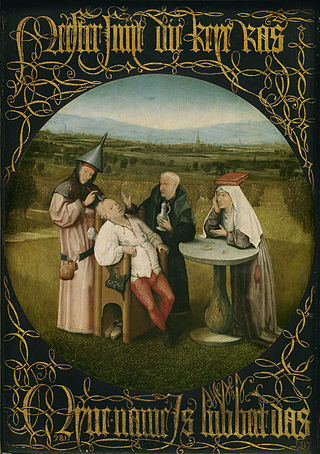Related Research Articles

1590 (MDXC) was a common year starting on Monday of the Gregorian calendar and a common year starting on Thursday of the Julian calendar, the 1590th year of the Common Era (CE) and Anno Domini (AD) designations, the 590th year of the 2nd millennium, the 90th year of the 16th century, and the 1st year of the 1590s decade. As of the start of 1590, the Gregorian calendar was 10 days ahead of the Julian calendar, which remained in localized use until 1923.

Year 1510 (MDX) was a common year starting on Tuesday of the Julian calendar.
Fouquet or Foucquet is a French surname. Many immigrants to the United States anglicized this surname to either Fuqua or Fuquay upon arrival.
The year 1681 in science and technology involved some significant events.

In surgery or medical procedure, a ligature consists of a piece of thread (suture) tied around an anatomical structure, usually a blood vessel, another hollow structure or an accessory skin tag to shut it off.

Ambroise Paré was a French barber surgeon who served in that role for kings Henry II, Francis II, Charles IX and Henry III. He is considered one of the fathers of surgery and modern forensic pathology and a pioneer in surgical techniques and battlefield medicine, especially in the treatment of wounds. He was also an anatomist, invented several surgical instruments, and was a member of the Parisian barber surgeon guild.
Laurent Colot (1520–1590) was a French physician.

Stephen Paget was an English surgeon and pro-vivisection campaigner. On the basis of the works of Fuchs, he proposed the "seed and soil" theory of metastasis, which claims the distribution of cancers are not coincidental. He was the son of the distinguished surgeon and pathologist Sir James Paget.
Paré is a family name of French origin. Some of the people who bear this name are:

Surgery is the branch of medicine that deals with the physical manipulation of a bodily structure to diagnose, prevent, or cure an ailment. Ambroise Paré, a 16th-century French surgeon, stated that to perform surgery is, "To eliminate that which is superfluous, restore that which has been dislocated, separate that which has been united, join that which has been divided and repair the defects of nature."

Damvillers is a commune in the Meuse department in Grand Est in north-eastern France.
Ambroise is a given name and surname. People with the name include:

Jacques Guillemeau (1550–1613) was a French surgeon from Orléans. He is credited for making pioneer contributions in the fields of obstetrics, ophthalmology and pediatrics.

Paré Glacier is a glacier 7 nautical miles (13 km) long and 1 nautical mile (1.9 km) wide, draining the northeast slopes of Stribog Mountains, and flowing east and then northeast into the head of Bouquet Bay on the northeast side of Brabant Island in the Palmer Archipelago, Antarctica.
The year 1510 in science and technology included many events, some of which are listed here.
Pierre Pigray was a French surgeon born in Paris in 1531. He was a student of the famous surgeon, Ambroise Paré before qualifying as a master surgeon in 1564. In addition to his service to the wounded in the Battle of Dreux (1562), Pigray was best known for being the surgeon-in-ordinary to King Charles IX, King Henri III, and King Henri IV. He died 16 October 1613.
Events from the year 1590 in France

In 1510, an acute respiratory disease emerged in Asia before spreading through North Africa and Europe during the first chronicled, inter-regional flu pandemic generally recognized by medical historians and epidemiologists. Influenza-like illnesses had been documented in Europe since at least Charlemagne, with 1357's outbreak the first to be called influenza, but the 1510 flu pandemic is the first to be pathologically described following communication advances brought about by the printing press. Flu became more widely referred to as coqueluche and coccolucio in France and Sicily during this pandemic, variations of which became the most popular names for flu in early modern Europe. The pandemic caused significant disruption in government, church, and society with near-universal infection and a mortality rate of around 1%.
References
- ↑ "Madame François Fouquet (1590-1681)". data.bnf.fr. Archived from the original on 25 July 2019. Retrieved 3 April 2018.
- ↑ Greeley, Ronald; Batson, Raymond (2001). The Compact NASA Atlas of the Solar System . Cambridge University Press. p. 378. ISBN 9780521806336.
- ↑ "[The surgeon of 4 kings, Ambroise Paré (1510 to 20 December 1590)]". Zeitschrift für Ärztliche Fortbildung: 1284–1287. 1990. PMID 2091407.